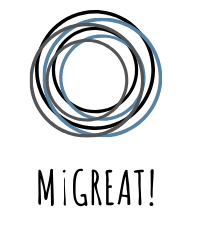“Lost of Whisperers in the Distance”
Interview with Mansour Forouzesh
Mansour Forouzesh is a 33 years old short film and documentary filmmaker from Iran, residing in Budapest, Hungary. He studied cinema. He has made 6 short story films and produced more than 10 TV documentaries. He is currently writing a feature film script in addition to filmmaking and also teaches several film workshops and master classes in Iran and the United Kingdom.
Mansour recently made a short feature film with the participation of Hungarian cinema professionals, which is in the process of being distributed and sent to festivals.
In the next few lines Mansour shares some interesting thoughts about his new project “Lost of Whisperers in the Distance” and he also tells about how he met with the MiGreat! project.
How did you meet Samira Sinai (project team member in Hungary, whom we wrote about in previous articles), and why do you think the Migreat! project is useful for the social inclusion of migrant people and the support of their education through Art methods?
Samira’s acquaintance happened many years ago because Samira has a significant background among Iranian artists. In addition, her parents are well-known artists. But my personal connection goes back to when I came to Hungary to study and was eager to make the documentary “Lost Whispers in the Distance”. Our friendship started because of this movie and I am very happy that this friendship has continued.
I think almost all of us agree that man is a social being in the general sense, and in fact human life depends on his relationship with the world around him and other human beings. It is this connection that instills in man a sense of worth and credibility and causes him to be accepted in society not only through his physical presence but also through his intellectual and spiritual life in society.
I think art gives all of us human beings the chance to be able to both turn our thoughts into an objective phenomenon and to be able to make connections beyond the usual connections with society through these works of art. So art and artwork, in addition to creating a sense of value, can be effective in creating communication and an exchange of ideas.
In addition, the process of creating a work of art, regardless of the medium, content, material and material value, can have a therapeutic function for an immigrant. Immigrants of all kinds generally suffer from a variety of emotional complications, and I think the process of producing a work of art can reduce the suffering caused by these emotional complications and put the person on the path to emotional recovery. Of course, this emotional condition is deeper for those who have been expelled from their homeland for any reason and are looking for a better life as asylum seekers.
What was your motivation to create this video, what is your aim with it, and what future perspectives would you appreciate about the topic and connected to the visual tool itself?
The video I shared with you is part of a feature-length documentary that tells the story of people caught in a miserable situation to find a better life. This deplorable situation, of course, is completely different from the perception they had when entering this path.
In fact, in this documentary we decided to look at the subject differently from most of the films that have been made so far. For example, most of the films made about asylum seekers had a direct and precise reference to the problems of these people, that is, in fact, these documentaries sought to improve the conditions of asylum seekers. But in our documentary, the situation is a little different, we sought to show the stark difference between asylum seekers’ perceptions of illegal immigration and the reality they face.
We hope that this film, which openly shares the problems with the audience, will give the necessary information to those who decide to migrate illegally through dangerous routes.
But the part I devoted to your project is about children. Children who actually spend a significant part of their lives on the road, in the mountains, in the forest, and in the camp, and generally suffer serious psychological and, in some cases, physical and sexual injuries. Aside from the fact that education and educational development conditions are almost impossible for them, these children are witnessing events along the way, each of which can cause serious psychological problems. That’s why I decided to share the children’s section with you.
How do you connect to migrant people in Europe, what message would you send them?
I would like to say that in addition to enlightening and raising awareness about what is happening to asylum seekers, it is necessary to produce content that targets those who are planning to enter the illegal immigration route. Of course, there are people who have actually been expelled from their countries for various reasons, but I think that a significant number of asylum seekers decide to immigrate illegally simply because they do not know or misunderstand. This is the point at which we, as producers of artistic and media content, seem to have a duty to pay more attention.
But apart from the issue of asylum seekers, anyone who decides to emigrate from any land, for any reason and with any background, is probably looking to build and find a different or better life and share experiences through art production and the media will play an important role in the development of all immigrants around the world.
Follow Mansour’s work here: https://hu.linkedin.com/in/mansourforouzesh
